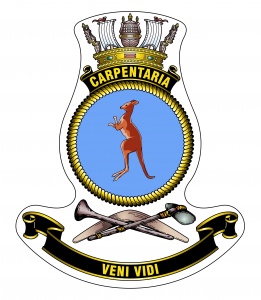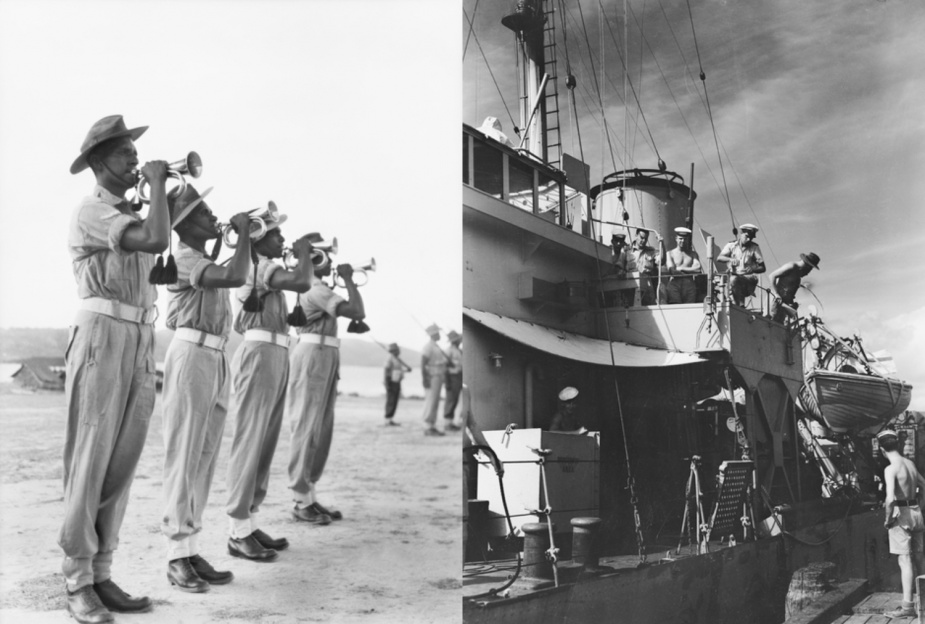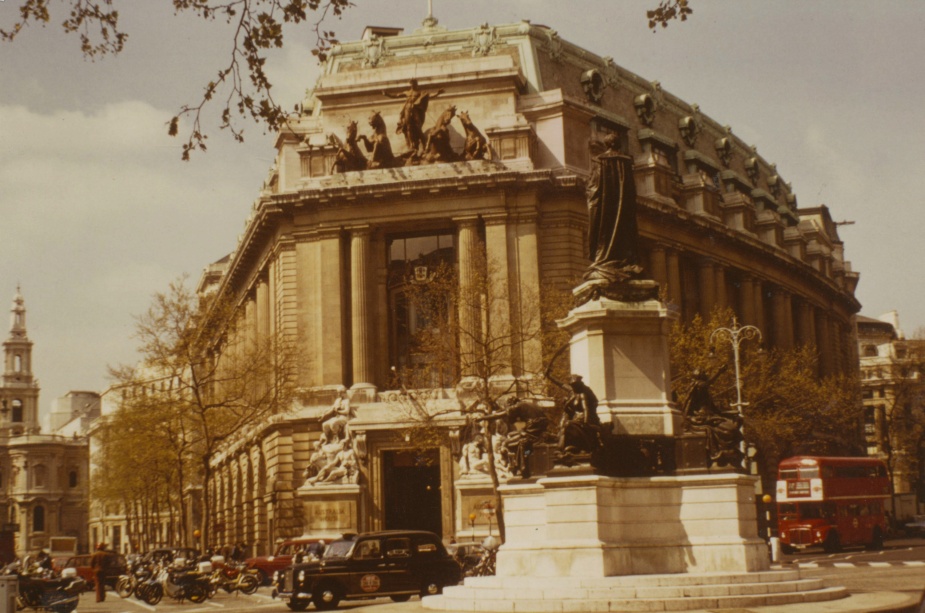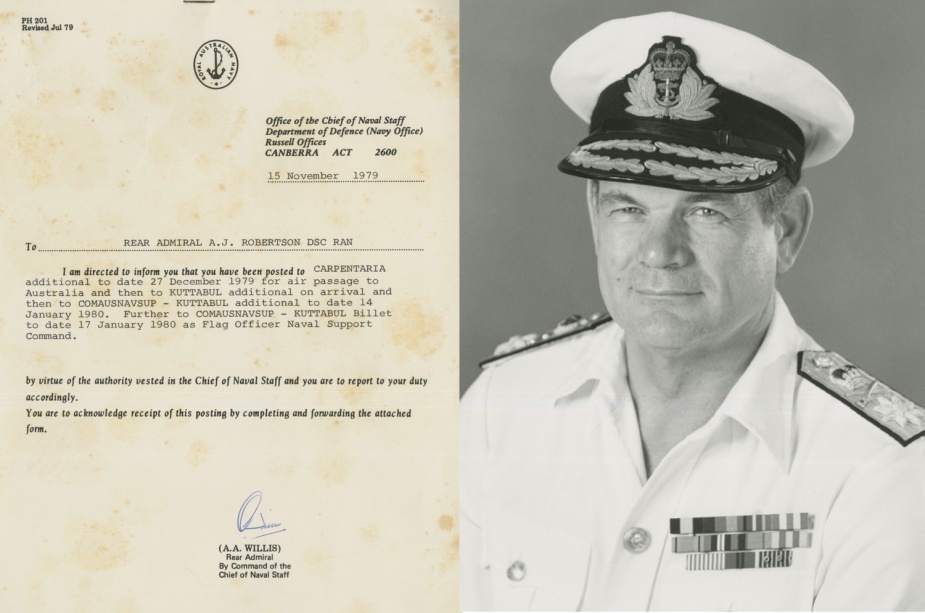HMAS Carpentaria
Two Royal Australian Navy shore establishments have been named HMAS Carpentaria. The first was a naval depot operating on Thursday Island (Waiben), located 30 kilometres off the northern tip of Cape York in the Torres Strait. The second was the RAN’s administration centre situated in London, UK.
HMAS Carpentaria (I)
The first Carpentaria was commissioned only for a short period of time, from 16 February 1945 until 30 June 1946. It was nevertheless the site of considerable activity during the Second World War.
Prior to the start of the war, Australian defence authorities identified the Torres Strait Islands as potential operational bases for aggressive foreign forces approaching Australia from the north.[1] With this in mind, personnel and stores were landed at Thursday Island on 19 October 1939, tasked with establishing and operating a Port War Signal Station (PWSS). The PWSS on Thursday Island was erected at Green Hill Fort complex. Constructed between 1891-93, Green Hill Fort offered panoramic views of Thursday Island harbour and Horn Island to the south, the Prince of Wales Island to the southwest, Friday and Goode Islands to the west, Hammond Island to the north.[2]
In the weeks following the RAN party’s arrival, stores and building materials were transferred to the nearby Wednesday Island and Booby Island, where wireless transmission stations were to be established. Much of this work took place during the night, “as this would obviate much of the mens’ [sic.] discomfort in the intense heat of the day.” Communication between Thursday Island and Wednesday Island was established on 4 November, and between Thursday Island and Booby Island on 15 November.[3]
In addition to the PWSS, the naval personnel on Thursday Island oversaw the construction of a Naval Office, docking facilities for vessels of up to 400 ton, and an oil fuel instillation with a capacity of 2000 ton of distillate, 2500 ton of diesel and 2500 ton of furnace oil.
Fixed defences included one 4.7-inch gun on Milman Hill at the centre of Thursday Island. Two 6-inch guns were also installed at Goode Island - these were originally from the cruisers HMA Ships Sydney and Melbourne and had been in storage since the two ships were scrapped in 1929.[4]
Naval personnel on Thursday Island were later joined by the Torres Strait Light Infantry (TSLI) Battalion.[5] Established in May 1941, the TSLI was a wholly Indigenous army battalion. The TSLI played an important role in the defence of the water reservoir and power house on Thursday Island, while local area knowledge was vital in navigating reefs and sandbars and laying underwater communication cable.[6]
The primary duties of the RAN personnel at Carpentaria included supporting anti-submarine patrols, convoy escort duties and the operation of the PWSS.
The Torres Strait was a strategically important shipping route connecting Darwin with the eastern seaboard of Australia. The PWSS at Carpentaria identified all vessels approaching the Torres Strait before granting them permission to pass. If a vessel could not be identified, RAN personnel would board the vessel in question, inspect it and clear it to enter the port. As an indicator of the volume of shipping passing through the area, in the twelve months between July 1943 and June 1944, a total of 471 vessels were cleared by Carpentaria personnel.[7]
Following Germany’s invasion of Norway and Denmark in April 1940, activities at Carpentaria greatly increased to ensure the invaded countries’ merchant shipping came under Allied control. All the Norwegian shipping using the Torres Strait at that time was made to anchor at Goods Island, to the north-west of Thursday Island. By 19 April, Norwegian ships Thordis, Havbør, Andersjahre, Hoegh, Giant, Skaraas, Skotaas and Norden had made anchor. An additional five officers, two petty officers, one leading hand and 34 ratings arrived at Thursday Island to provide an armed guard for the onward journey of these ships. The Norwegian ships were subsequently escorted to Sydney, Darwin and Singapore, where they were placed under British control.[8]
Prior to the Second World War, Thursday Island, Cairns, Darwin and Broome were each major pearling ports and home to many people of Japanese descent who worked as pearl divers and trepang fishers. After the attack on Pearl Harbor, all people of Japanese descent on Thursday Island were detained in their homes as a precautionary security measure. These detainees were later transported by sea to mainland Australia where they were held in internment camps for the duration of the war.[9]
Other civilians on Thursday Island also felt the impact of the Pacific War. In the wake of the fall of Singapore, and the 1942 aerial attacks on Darwin, all women, children and non-essential civilians living on Thursday Island and Horne Island were evacuated, as they were considered to be vulnerable to potential attack and invasion.[10]
During the war, many thousands of German GY, Japanese JA and Australian Mk XIV mines were laid in Australia’s coastal waters. Consequently Rendering Mines Safe (RMS) units were established to inspect and disarm those mines found drifting. Three RMS personnel were stationed at Carpentaria, where they rendered safe mines that had washed ashore. The majority of RMS activities took place towards the end of the Second World War as the Japanese threat diminished and in the months immediately following the war.[11] By mid-1946, with RMS activities no longer required, Carpentaria decommissioned on 30 June 1946.
HMAS Carpentaria (II)
The second establishment commissioned under the name Carpentaria was in London from 1 January 1966 to 31 October 1981. Unlike most other shore establishments with coastal defences, docking facilities and naval workshops, Carpentaria was strictly an administrative centre and was housed in the offices of the Australia High Commission. The staff at Carpentaria provided advice on a range of defence policy issues, acquisition and training.
The RAN’s presence in London was particularly important during the rebirth of the Australian Submarine Service. In 1963, the Naval Board ordered four of the British Oberon Class submarines, with construction taking place in Scotland and beginning in 1964. RAN personnel travelled to the United Kingdom for submarine training, meaning that when each of the four vessels commissioned and departed for Australia, the crews were almost entirely members of the RAN.[12] Among the responsibilities of the Australian Naval Representative at this time, Commodore DHD Smyth, RAN, were the supervision of the training program and the construction of the new submarines. The role of Australian Naval Representative in London proved to be an important diplomatic posting in the careers of many of the RAN’s luminaries. Among those who served at Carpentaria were future Chiefs of Navy Vice Admiral David W Leach and Rear Admiral Ian Herbert Richards.
Works cited
- ↑WWII NQ: A Cultural Heritage Overview of Significant Places in the Defence of North Queensland, Queensland Government, Environmental Protection Agency, 2009, 50.
- ↑Green Hill Fort, Chester St, Thursday Island, Qld, Australia, Australian Heritage Database:
http://www.environment.gov.au/cgi-bin/ahdb/search.pl?mode=place_detail;place_id=105419. - ↑War Diary of Thursday Island War Signal Station and Torres Strait Lighting Control Service, October 1939-May 1940, Australian War Memorial (AWM) 78, 398/1.
- ↑Naval Bases, SPC-A; WWII NQ, 50.
- ↑The TLSI was a unit until May 1943, when it was granted battalion status.
- ↑Vanessa Seekee, Horn Island 1939-1945: A record of the defence of Horn Island during World War Two (Vanessa and Arthur Liberty Seekee, Horn Island, 2002), p. 89; Vanessa Seekee, ‘One ilan man: the Torres Strait Light Infantry’, Wartime No. 12:
https://www.awm.gov.au/about/our-work/publications/wartime/12/ilan-man. - ↑Naval Bases, SPC-A.
- ↑War Diary of Thursday Island, 1939-May 1940, AWM 78, 398/1.
- ↑Seekee, pp. 8, 10.
- ↑WWII NQ, pp. 12, 14.
- ↑Mike Turner, RMS Operations by the RAN in the Pacific - World War II, Naval Historical Society:
https://www.navyhistory.org.au/rms-operations-by-the-ran-in-the-pacific-world-war-ii/. - ↑The RAN Oberon Class - The First Australian Submarine Squadron, Submarine Institute of Australia:
https://www.submarineinstitute.com/submarines-in-australia/The-RAN-Oberon-Class.








